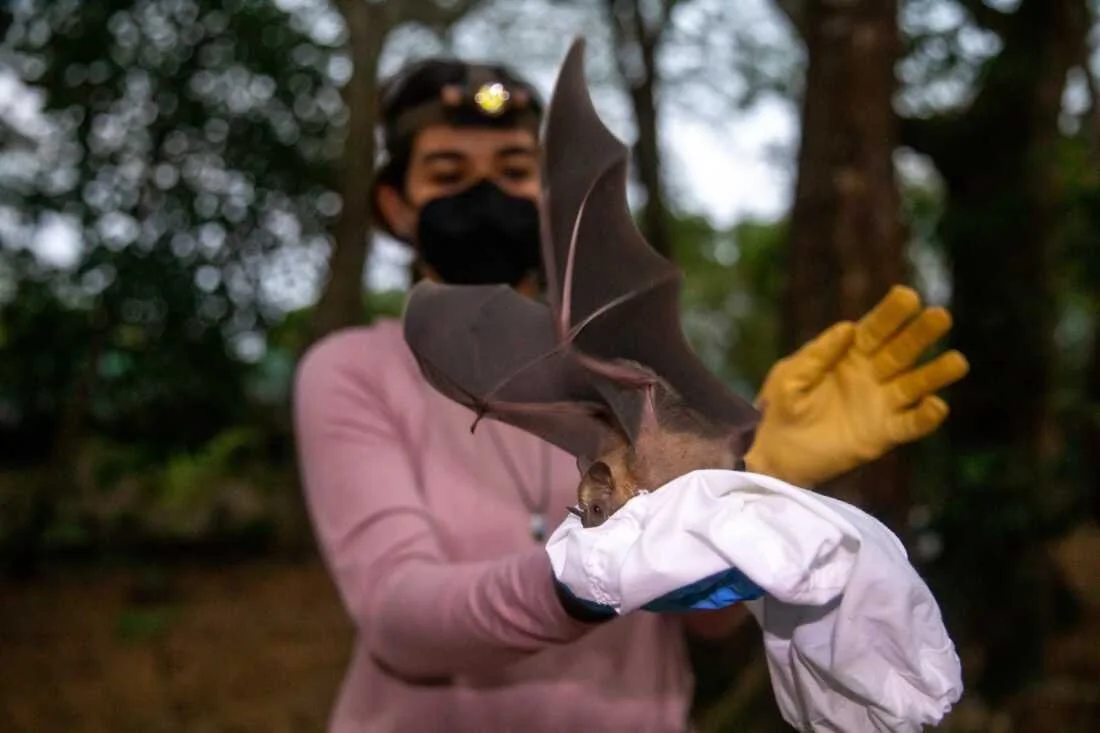
In the news
*
In the news *

Listen up.

Bat-Vision.
Empire of bats
Documentary about Bat-a-thon (Fenton & Simmons, 2000), filmed in the rich jungle of Lamanai, Belize, a 3,000-year-old Mayan community and long-term site for bat research. Each year, 70–80 scientists participate in this two-week field study to survey most of the 45 bat species found in the region.
Our group is featured in the film discussing nectar bat biology and how “bats can thrive on extreme sugar diets”.
Beyond our work on molecular and cellular adaptations, we are also known for identifying a second nectar-feeding species, Glossophaga commissarisi. This species was first recognized by Bernal-Rivera (2022) after noticing subtle differences in feeding behavior and confirming the distinction through dental morphology. The finding was later validated by Dr. Nancy Simmons (AMNH) using both morphological and molecular analyses, expanding previous records that recognized only one nectar-feeding species at Lamanai.
Bats are thriving on nothing but sugar
Nectar-feeding bats have evolved remarkable strategies to survive on extreme sugar diets, offering new insights into metabolic resilience and health.
Our recent paper reports the highest naturally occurring blood sugar concentrations ever observed in mammals. As co–first author alongside Andrea Bernal-Rivera, I helped lead this study from the Stowers Institute.
The Truth About Bats and SARS-CoV-2
When COVID-19 first emerged, misinformation about bats spread almost as fast as the virus itself. I gave this talk to help separate rumor from evidence and remind people that bats aren’t villains—they’re vital to healthy ecosystems. I spoke about what we know from science, how viruses evolve in nature, and why understanding these connections matters more than assigning blame. This presentation was part of Clubes de Ciencia (MX), a science outreach program that connects researchers with students across Latin America to promote hands-on learning and scientific dialogue.
Stowers scientists explore how bats can help humans
I was featured on KCTV5 News, a CBS-affiliated local station in Kansas City, to help make our research more accessible to the public. The segment highlighted how studying nectar-feeding bats can help us understand human metabolism. It reminded viewers that bats and humans are both mammals and share much of the same biology. Learning how bats stay healthy on a sugar-rich diet can give us new ways to think about metabolic health and disease.
Morning Medical Update – Diet and Diabetes
I joined Morning Medical Update, a podcast where experts from The University of Kansas Health System discuss current health topics and advances in medicine. In this episode, I talked about my research on nectar-feeding bats and their ability to thrive on a diet made entirely of sugar. Understanding how these bats maintain healthy metabolism under extreme glucose levels may offer new perspectives on diet, diabetes, and metabolic resilience.

Stories & Profiles
Curiosity and the Science of Resilience
Feature by Isabella Cueto, STAT News
This STAT profile traces my journey from growing up in Salinas, California, to leading research on the biology of resilience in nectar-feeding bats.
Named HHMI Hanna H. Gray Fellow
Feature by the Stowers Institute for Medical Research & also highlighted in The New York Times
This feature announced my selection as an HHMI Hanna H. Gray Fellow, which supports my transition to independence and reflects my broader goal of understanding how life adapts to extreme environments.
Nectar Bats Are ‘Wonderful, Majestic’ and Sugar-Obsessed
Feature by Justin Chen, STAT News (Health – STAT+)
This STAT News article features my research on nectar-feeding bats. I shared how studying these bats can help us understand the biology of metabolism and what their resilience might reveal about human health.



